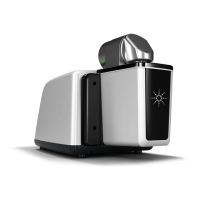Analyzing Samples
34 Agilent Cary 630 FTIR Spectrometer User’s Guide
Germanium ATR Sampling Accessory
The Agilent Germanium attenuated total reflectance (Ge ATR)
sampling accessory for the Cary 630 FTIR takes advantage of the
physical properties of light when encountering two materials with
differences in index of refraction. When coming in contact with a
sample having a different index of refraction, the infrared light creates
an evanescent wave, which provides a very small and specific depth of
penetration into the sample before reflecting back into the detector of
the spectrometer. This small and consistent pathlength means no
sample preparation is required to get good measurement results from
a variety of samples. The Ge ATR, while similar in design to the
Agilent diamond ATR accessory, offers different characteristics due to
the use of a Ge crystal. Shallower depth of penetration is achieved
with a Ge crystal, resulting in a shorter pathlength. This is important
when measuring samples containing carbon black, such as tires,
rubbers and o-rings, as the characterization and identification of these
highly absorbing samples is made simpler with shorter pathlengths.
The key to obtaining good results with the Ge ATR accessory is to
make good contact between the sample and ATR crystal. The ATR
technique can be used for analyzing liquids, pastes, powders and solid
samples.
The Ge ATR accessory uses a single bounce 45° crystal as the interface
between the sample and the infrared energy and is a single-reflection
ATR. It is most suitable for higher absorbing samples such as tires,
rubbers and o-rings, or any sample containing carbon black. Powder
and solid samples are also best measured with the single-reflection
ATR, by using the sample press device, which applies high pressure to
powder and solid samples to ensure good contact with the Ge crystal.
The single-reflection ATR is also a good choice when the amount of
available sample is limited. The single-reflection Ge has a 1 mm
diameter sampling surface and provides the following effective
pathlengths:
0.15 μm at 4,000 cm
-1
0.36 μm at 1,700 cm
-1
1.02 μm at 600 cm
-1

